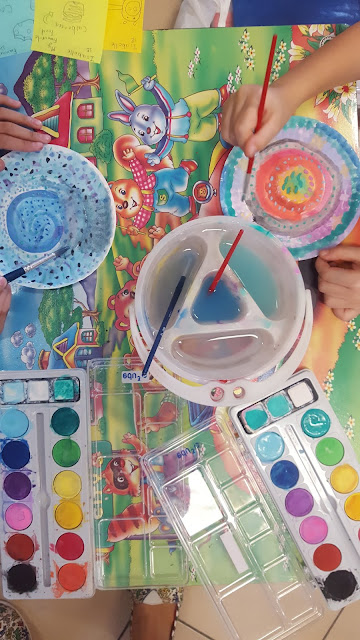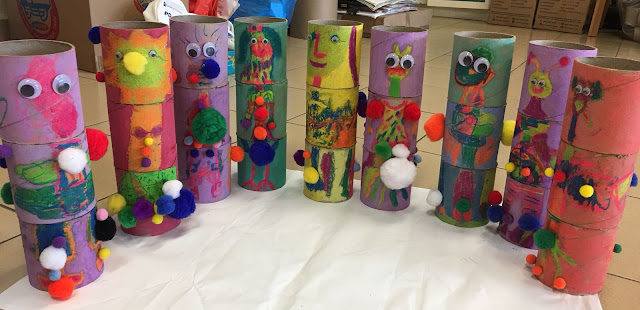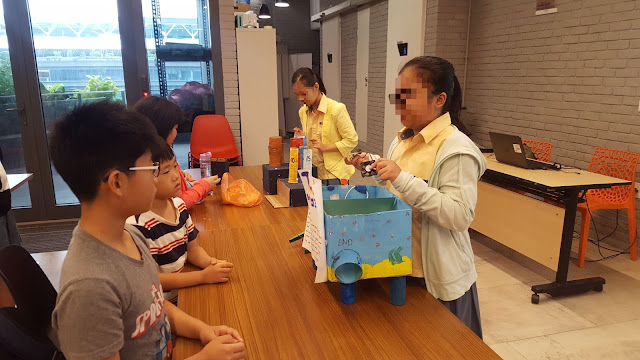Art Club pupils participated in a Strawbees Challenge at the Makers Faire last week. There were students' prototypes displayed at the perimeters of the booth with some incorporating electronics and recycled materials. I like how the children took initiative to interact with the facilitators whom they are seeing for the first time. This authentic experience of holding a conversation with people beats punching letters on smartphones. They would also need to describe more about their artwork to the judging panel. I'm also very thankful for their parents for making the time and effort to support their children's interest.
Tabs under construction!
Thursday, August 23, 2018
Sunday, August 19, 2018
Art Class: Clay Food I
In tandem with International Dot Day, the children painted paper plates to go with their clay food. As a tuning in, I asked the children to draw me the answers to these questions on post-its:
Food is a great conversation starter. There is always food during celebrations. Be it festive seasons, weddings, birthdays, parties, housewarming or vernissage. There is no lack of intagrammable dishes in images to arouse your appetite. In short, people don't just eat when they are hungry. We are also social eaters unless you are looking for what founder, Marina Van Goor, has designed - Eenmaal, a restaurant only for solo diners.
I've learnt more about the children through the food that best depicts their culture. It was also interesting to find out about their favourite food and snacks which tell me a lot based on their food choices and lifestyles.
The children responded very well to images - either digital or printouts. We started by looking at our school location on Google Map and found that many restaurants including fast food eateries are strategically situated near our school. We discussed our favourite food, festive foods and food we need to eat in moderation. There was also a lesson where the children manipulate the clay into specific shapes so that they can experience the colour change and describe the difference in 2D and 3D shapes. We observed the shapes, colours and they did a few sketches.
Food is a great conversation starter. There is always food during celebrations. Be it festive seasons, weddings, birthdays, parties, housewarming or vernissage. There is no lack of intagrammable dishes in images to arouse your appetite. In short, people don't just eat when they are hungry. We are also social eaters unless you are looking for what founder, Marina Van Goor, has designed - Eenmaal, a restaurant only for solo diners.
I've learnt more about the children through the food that best depicts their culture. It was also interesting to find out about their favourite food and snacks which tell me a lot based on their food choices and lifestyles.
The children responded very well to images - either digital or printouts. We started by looking at our school location on Google Map and found that many restaurants including fast food eateries are strategically situated near our school. We discussed our favourite food, festive foods and food we need to eat in moderation. There was also a lesson where the children manipulate the clay into specific shapes so that they can experience the colour change and describe the difference in 2D and 3D shapes. We observed the shapes, colours and they did a few sketches.
Labels:
artclass,
clayfood,
primarythree
Sunday, August 12, 2018
Housekeeping: Drawing on Fabric
The process of preparing children's art installation (on fabric) is mostly very calculated. My colleague and I measured the hallway doors, amount of fabric needed, suitability of the quality of the fabric and even sewing. The colour choice of the thread that will complement the fabric has to considered too. We were in luck when our colleague has a hemming machine and she brought it to school to sew! So we were done in no time.
Labels:
artgallery,
displays,
housekeeping
Sunday, August 5, 2018
Art Class: Exquisite Corpse
The children ended their collaborative artwork of exquisite corpse. This drawing game was invented by the Surrealists in 1920s. Each artist agrees to draw a part of a figure (head, torso & tails/legs) and then put them together in the end to create a bizarre drawing where each part of the figure contrast with each other. I've adapted the game by getting the children to draw on toilet paper tubes with oil pastels and doing watercolour resist. More importantly, they can all do their drawings at the same time and put their artwork together as shown above and manually rotate the artwork to see how the final piece changes each time they turn the images. Hot-glue gun was used to stabilise the final piece.
The children added pom poms to their artwork and chose the sizes of the googly eyes for the teachers to hot-glue them. I used diluted Chinese ink for my first class but realised that it didn't work too well for the oil pastels to show. Eventually, I had to make do with watercolour cake.
The children were introduced to one of the art inquiry approach: Beginning, Middle, End. They observed and drew their 3D artwork on a piece of paper divided into three parts to represent the flow of a story.
 |
| Reading stories written by others from another class |
Labels:
artclass,
primaryone
Sunday, July 29, 2018
Art Club: Learning from the Pro
Sharpening my pottery skills with two other teachers in school every Friday afternoon. We even had a lesson with a Ceramist, Mr Chua, in his studio. Soon, we'll be able to fire our students' work on our own.
While I have taken ceramics classes before and the procedural steps are similar, what was missing in my previous experience is that the teachers aren't glaze chemist or connoisseur. However, with more learning in theoretical areas such as explanation in Chemistry and listening to someone learned in terms of depth and breadth is few. As a teacher to younger charges, the teacher has to always be the one adapting to the learners whereas, for adult learners, we are the ones adapting to our teachers, be it in communication or mannerism. I could still produce decent pieces despite the different instructions. I know given time, resources and a will to do better, we can improve our skills. So, when Mr Chua leaves, we would be fending for ourselves but I know he will only be a phone call away! :D
Careful attachment of different parts of a cup or motifs in a piece is crucial, otherwise, this initial step would lead to wasted effort and time in the end.
Trimming is essential in making pots. It removes excess clay and unnecessary weight in a piece. It also smoothens the surface evenly quite quickly. Usually done when the clay is leather hard, a term used to describe clay that has some moisture but not too wet or dry for this step. The removed clay are noodle-like and I don't have to exert too much pressure. But when it is bone dry, the removed clay would be powder-like and brittle.
Before you judge us for this abused kiln shelf, our role now is more of a custodian for these properties. We learnt to use batt wash to protect this shelf and to prevent further degeneration. Troubleshooting is one of the things high on my list. We can do everything as we were taught but certain circumstances would require one's thinking to be out of the box. For example, teaching children and adults are vastly different. The characters with whom we are interacting every day have different learning needs. Much more if they require special attention. We need to think of the learners' movement and placement of supplies. We need to place the materials in accessible places and delegate roles to the children so that they can take some responsibilities for their learning. Throughout the learning, there are bound to be teachable moments, peer feedback and exploration. These implicit or hidden curricula are often unsaid or hardly replicated by others.
 |
| Photo credit: Aznani |
Monday, July 23, 2018
Art Club: Children's Workshop by Children
2 weeks ago, art club pupils conducted a workshop for children at a community library. Each of them had the opportunity to present their year-long project of making a DIY game incorporating LittleBits components. The participants also got to bring home their own LED paper twirler. It was a pity some participants did not turn up due to the morning shower. Nevertheless, it was a comfortable group that the children were able to handle. At the end of the workshop, some of them slumped on the chair and exclaimed that it was SO TIRING to teach the younger ones. Talk about teachers' routines... I'm sure the children would internalise the concept of delayed gratification.
Last, a BIG shout out to my colleague, Candice, for sending the children's bulky artwork to the library and back to school!
Last, a BIG shout out to my colleague, Candice, for sending the children's bulky artwork to the library and back to school!
Labels:
artclub,
ArtSci,
electronics,
littlebits,
workshop
Subscribe to:
Comments (Atom)

























































